BOYA BY-WM6 Handleiding
Bekijk gratis de handleiding van BOYA BY-WM6 (1 pagina’s), behorend tot de categorie Microfoon. Deze gids werd als nuttig beoordeeld door 94 mensen en kreeg gemiddeld 4.5 sterren uit 47.5 reviews. Heb je een vraag over BOYA BY-WM6 of wil je andere gebruikers van dit product iets vragen? Stel een vraag
Pagina 1/1

BOYA AU DIO EOU IPMENT (SHENZH EN) CO., LIM ITE D
Add: A16 building, New Material Indu st rial Park of Silicon Valley Power, Guanla n Town, Shenzh en, China
Tel: (86) 0755-28435910
Email: sa les@boya-mic.c om
www.boya-m ic.com
,QVWUXFWLRQ0DQXDO
BY-WM6
Thanks for choosing BOYA!
The BOYA BY-WM6 is an UHF wireless microphone system, designed for ENG
(electronic news gathering), EFP (electronic field production), DSLR video, and
other professional applications.
The receiver and the transmitter are lightweight and simple menu for easy
operation.
The BY-WM6 consists of a body-pack transmitter, a portable receiver, and their
accessories as following:
Omni-directional lavalier microphone Stereo 3.5mm mini plug cable
XLR output cable Micropho ne Holder clip
Wind screen Belt clip
Shoe mount adapter
Installing Batteries
The transmitter, receiver are each powered by two AA batteries. To install
batteries, please follow these steps:
10
12
11
7
9
8
4
5
3
6
2
1
1. Turn OFF the units, Slide the battery-compartment catches inward
(in the direction of the arrows “ , ”).← → Battery indication
When you turn the power on, the battery condition is shown by the BATT
indication in the display section.
Be sure to check the expiration date printed on the new batteries before
using them.
NOTE
1.The indicated battery condition may not be correct if the batteries were not
new when installed. If you plan to use the units for a long period, it is
recommended that you replace the batteries with brand new ones.
2.Insufficient battery power can decrease the ability of transmitter and receiver.
Therefore, make sure your batteries start out with a full charge when using
this system, and always carry spare batteries.
Notes on battery
Batteries may leak or explode if mistreated.
Be sure to follow these instructions:
1.Make sure install the batteries with correct polarity.
2.Always replace two batteries together.
3.Do not use different types of batteries or old and new one together.
4.When not using the components for a long period of time, remove the
batteries to avoid leakage. If the batteries do leak, clean all leakage from
the battery compartment and the component.
Leakage left in the compartment and the component may cause poor battery
contact. If there seems to be poor battery contact, please consult our local
dealer.
Attachment and Installation Procedures
Attaching the supplied accessories to the body-pack transmitter
To attach the microphone
For a secure connection, be sure to turn and lock the connector cover.
NOTE
Make sure to attach or remove the microphone after turning off the transmitter.
To attached the holder clip to the microphone
Push the holder clip against the bottom of the microphone until the holder clip
clicks into place.
To attach the wind screen to the microphone
Insert the microphone into the hole at the bottom of the windscreen.
To remove the belt clip
Insert a pointed object such as a ballpoint pen between the belt clip and the
transmitter to make some space between them, and then remove the end of
the belt clip from the hole on the side of the transmitter.
Attaching the supplied accessories to the body-pack
transmitter
To connect the supplied conversion cable to the OUTPUT
connector
For a secure connection, be sure to turn and lock the connector cover.
Too much
ambience is
being picked
up.
When using an omnidirectional
microphone like the one
included with this system, the
microphone may be picking up
too much ambience.
Make sure the microphone
is as close as to the subject.
Frequency Chart
Channel CH)(Frequency(MHZ) Channel CH) Frequency(MHZ) (
1
2
Specifications:
System
Oscillator type: PLL Synthesized Control Oscillator
Carrier Frequency Range: 584 MHz-608 MHz
Channels: 48
Frequency response: 60Hz-15 KHz+/-3 dB
Operation range: 100m (300')(without obstacle)
Operating temperature: 14° F to 122° F (-10 to +50 )℃ ℃
Storage temperature: 14° F to 131° F (-10 to +55 )℃ ℃
Transmitter
RF output power: 20 mW
Antenna: Flexible
Spurious emission: 250 nW or less
Audio input connector: 3.5mm mini jack
Audio input level: 600 mV-2000 mV
Reference deviation: ±7KHz (-60 dBV, 1 KHz input)
Input frequency range: 20 Hz-20 KHz
Power supply: Two AA batteries
Operation time: 8 hours
Dimensions: (H x W x L) 4.2” x 2.6” x 1.1”
(10.6 x 6.7 x 2.9 cm)
Weight: 95g (3.4 oz) without batteries
Receiver
Antenna: Flexible
Audio input connector: 3.5mm mini jack
Signal-to-noise ratio: 80 dB
Distortion: 0.8% (-60 dBV, 1 KHz input)
Earphone output level: 60 mW, 32 Ohms/1KHz
Audio output level: 120 mV
Power supply: Two AA batteries
Operation time: 8 hours
Dimensions: (H x W x L) 4.2” x 2.6” x 1.1”
(10.6 x 6.7 x 2.9 cm)
Weight: 98g (3.5 oz) without batteries
Lavalier Microphone
Transducer: Back electret Condenser
Polar pattern: Omni-directional
Frequency Range: 35Hz ~ 18 KHz
Signal / Noise 74dB SPL:
Sensitivity: -30dB +/-3dB / 0dB=1V/Pa, 1 kHz
Connector: 3.5mm locking mini plug
Length: 1.2m (4’)
Transmitter
1. Antennat
2. Line In
3. Microphone input
Connect the supplied lavalier microphone
here. Fully insert the microphone’s
3.5mm plug and make sure it clicks into
place, then lock the plug.
To remove,release the locking mechanism,
then pull the plug out.
4. Power/Mute button
1) Long press the power of the transmitter
ON or OFF
2) Short press for muting
For more details about LED indicator, please refer to as following:
Situation
The transmitter and the receiver connects.
The transmitter and the receiver disconnects.
Transmitter Receiver
Stays blue Stays blue
Stays blue Flash blue
6. CH (Channel) indication
Shows the transmission channel.
7. Battery indication
Shows the battery condition
NOTE
When the battery power icon is empty and blinking, the batteries are almost
out of power, and you will need to change the batteries immediately.
8. + (+ selection)/ – (- selection) buttons
Press these buttons to set the transmission channel, or attenuation level of
the input signal.
For details, please see “How to set up channel and VOL” on page 13.
9. SET button
Press to change and enter display parameters.
For details, please see “How to set up channel and VOL” on page 13.
10. Belt clip
11. Battery compartment
Accommodates two AA batteries.
For more details, please see “Installing batteries” on page 7.
2
1
3
4
5
67
8
9
10
11
Receiver
1. Antenna
2. Monitor Connector
(3.5mm diameter stereo mini jack)
To monitor the receiver output, connect
the headphones to this connector.
NOTE
Do not connect headphones with a
monaural mini jack.
This may lead to short-circuiting
of the headphone output, resulting
in distorted sound output.
4. Power
Press this button to turn the receiver ON or OFF.
5. Power LED
1) The power LED glows blue when the unit is on.
2) The power LED glows red when low power.
For more details about LED indicator, please refer to as following:
Situation
The transmitter and the receiver connects.
The transmitter and the receiver disconnects.
Transmitter
Stays blue
Stays blue
Receiver
Stays blue
Flash blue
6. CH (Channel) indication
Shows the transmission channel.
7. Battery indication
Shows the battery condition
NOTE
When the battery power icon is empty and blinking, the batteries are almost
out of power, and you will need to change the batteries immediately.
8. + (+ selection)/ – (- selection) buttons
Press these buttons to set the transmission channel, or attenuation level of
the input signal.
For details, please see “How to set up channel and VOL” on page 13.
9. SET button
Press to change and enter display parameters.
For details, please see “How to set up channel and VOL” on page 13.
10. Belt clip
11. Battery compartment
Accommodates two AA batteries.
For details on how to insert the batteries, please see “Installing batteries”
on page 7.
12. Shoe mount adapter
NOTE
Please make sure the units is turned OFF, because taking out the battery
compartment during signal transmission may cause high noise.
3. Insert the batteries into the battery compartment by matching their
polarities to the indications inside the compartment. Then, set the
battery holder in the original position.
To attach the shoe mount adapter
Before attaching the shoe mount adapter, attach the belt clip.
Reorienting the belt clip: The BY-WM6’s belt clip can easily be removed and
reattached to the body pack, so you can mount it upside down. To reorient the
belt clip, please follow the below steps:
1.Push outward on the belt clip at one of the hinges, so one side of the clip
pops out.
2.Push the belt clip out from the other hinge to completely remove the clip
from the body pack.
3.Realign the belt clip with the body pack, making sure the clip is facing the
desired direction.
4.Insert the two-way belt clip into the body pack, one hinge at a time.
To attach the shoe mount adapter
Connecting the Transmitter and the Receiver
To connect the transmitter and the receiver, follow these steps:
1.Make sure the supplied lavalier microphone connect to the transmitter’s
microphone input or plug a line-level source into the transmitter’s line input.
Note: If you are connecting the receiver to a sound system, mute the sound
system. Do not monitor with the headphones at the stage. Anytime you are
changing the channel, remove your headphones and mute connected sound
systems to avoid audible RF noise bursts.
2.Turn on the transmitter and the receiver.
3.Set the transmitter and the receiver to the same channel. If you are
experiencing interference or noise on one channel, try a different channel.
Noted:1) If you are using multiple BY-WM6 wireless systems, make sure
each system is set to a different channel, which can reduce the
chance of intermodulation.
2) If the transmitter and the receiver connect, the power indicator
stays blue. Otherwise, if the power indicator flash blue, that
means, the transmitter and the receiver is disconnected.
3) The results are stored in memory automatically. The stored
channel number will appear in the display section in next time if
you turn on the transmitter and the receiver.
4.With the headphone volume low, plug your headphones into the receiver and
gradually raise the level to a comfortable volume for monitoring the
transmission.
6. Once you have determined the transmission quality and level are good,
mount the transmitter and the receiver.
NOTE
1.When you are setting the transmission channel, the transmitter cannot
be used to transmit signals.
2.Do not remove the batteries while setting the transmission channel.
How to set up channel and VOL, please follow the below steps:
Set up Channel
Turn on the transmitter and the receiver, if the display section shows “CH”.
-Press the + (+ selection) button for increasing the channel number.
-Press the – (- selection) button for decreasing the channel number.
-Long press +/- buttons, the channel number will increase and decrease
automatically.
Set up Volume
-Press “SET” button, the display section shows “VOL”
-Press the + (+ selection) button for increasing the volume number.
-Press the – (- selection) button for decreasing the volume number.
-Long press +/- buttons, the volume number will increase and decrease
automatically.
For more details about VOL function, please see the below:
VOL
+/-
Transmitter
Adjust attenuation level of the
input signal.
Receiver
1. Adjust sound recording level.
2. Adjust monitor sound level.
Important Notes
On usage and storage
.
Operating the BY-WM6 components near electrical equipment
(motors, transformers, or dimmers) may cause it to be affected
by electromagnetic induction.
Keep the BY-WM6 components as far as from such equipment as possible.
. The presence of the lighting equipment may produce electrical interference
over the entire frequency range. Position the BY-WM6 components so that
interference is minimized.
. To avoid degradation of the signal-to-noise ratio, DO NOT use the BY-WM6
components in noisy
Place or in locations subject to vibration, such as the following:
- Near electrical equipment, such as motors, transformers, or dimmers.
- Near air condition equipment or places subject to direct air flow from an air
conditioner.
- Near public address loudspeaker.
- Where adjacent equipment might knock against the receiver.
Keep the BY-WM6 components as far from such equipment as possible or use
buffering materials.
On cleaning
Clean the surface and the connectors of the BY-WM6 components with a dry,
soft cloth. Never use thinner, benzene, alcohol or any other chemicals, since
these may mar the finish.
Troubleshooting
If you have any problem using the BY-WM6 components, use the following
checklist.
If any problem persist, please consult our local dealer, or contact us directly.
Symptom Meanings Remedy
The units does
not turn on
The polarity orientation of the
batteries in the battery
compartment is incorrect.
The batteries are exhausted. Replace the batteries with
new ones.
The battery terminals in the
transmitter are dirty
Clean the + and - terminals
with cotton swab.
Insert the batteries with the
correct polarity orientation.
The batteries
become drained
quickly.
The batteries are exhausted. Replace the batteries with
new ones.
Manganese batteries are being
used.
Use alkaline batteries. The
battery life of a manganese
battery is less than half that
of an alkaline battery.
The BY-WM6 components is
being used under cold
conditions.
The batteries drain quickly
under cold conditions.
The channel
cannot be
changed
An attempt was made to
change the channel by
pressing the SET button only.
There is no
sound.
The channel setting on the
transmitter is different from
that on the receiver.
Use the same channel setting
on both the transmitter and
receiver.
The sound is
weak.
The attenuation level on the
transmitter is too high.
The input level of the
transmitter is low. Press the -
button on the transmitter in
attenuation level setting
mode to decrease the
attenuation level.
The line input is selected on the
transmitter.
Pull the cable out from LINE
IN.
There is
distortion in the
sound
There is
distortion in the
sound
The attenuation level on the
transmitter is too low.
The input level of the receiver
is extremely high. Press the +
button on the transmitter in
attenuation level setting mode
to increase the attenuation
level.
The transmitter and the
receiver are set to
different channels.
Set the transmitter to the
same channel.
Headphones with a mon-
aural min jack is used.
Use the headphones with a
stereo mini jack.
RF interference
.Try a different channel. Make sure
both units are on the same
channel.
.Try to position the antennas at a
45° angle in relation to each other.
There can be a lot of RF
interference outdoors.
.Try moving indoors, where there
is less RF interference.
.Keep the units' antennas at least
2'(0.6m) away from conductive
objects like metal and water.
.Overhead telephone lines,
fluorescent lighting, and metal
fences can all cause interference.
.Turn off all nearby computers
and mobile phones.
The audio is
noisy or
distorted. This
can include drop
outs, white
noise, bursts,
pops and clicks.
RF signal is weak.
Make sure there is an unobstructed
line of sight between the
transmitter's and the receiver's
antennas.
Keep in mind that your body,
clothes, and onstage sets are
possible obstructions.
Make sure the receiver and
the transmitter are within
328'(100m) range.
If there are obstructions, you
may need to move closer.
The input level on the
camera, recorder, or
mixer is too high.
Turn down the audio input level on
your camera or recording device.
Lower the audio output level on
the receiver.
Turn down the gain on your mixer.
If there is no adjustment on the
device, and the level is still high,
adjust the microphone level on the
transmitter. Keep this level as high
as possible without distortion.
123 4
5 6 7 8
9
5. Power LED
1) The power LED glows blue when the unit is on.
2) The power LED glows red when low power.
3. OUTPUT (audio output) connector (3.5mm diameter stereo mini jack)
Connect one end of the supplied stereo 3.5mm mini plug-BMP conversion or
XLR-BMP conversion output cable here, and the other end to the microphone
input on a DSLR camera, camcorder, mixer, or amplifier etc.
2. Take out the battery holder.
8+):LUHOHVV0LFURSKRQH6\VWHP
5. The Channel and Volume of the Transmitter and the Receiver are “CH-1”
and “VOL-24” when turn on them for the first time.
- Adjust channel as you need.
- Adjust as necessary to make sure an ample level is being transmitted to
the receiver.
The objective is to transmit the highest level without distortion for the
best signal-to-noise ratio throughout the signal path.
Restart the unit, then change
the channel with the + and -
buttons.
This device complies with part 15 of the FCC Rules.
Operation is subject to the following two conditions:
(1) This device may not cause harmful interference.
(2) This device must accept any interference received, including interference
that may cause undesired operation.
Warning: Changes or modifications to this unit not expressly approved
by the party responsible for compliance could void the user’s authority to
operate the equipment.
NOTE: “This equipment has been tested and found to comply with the limits for a
Class B digital device, pursuant to Part 15 of the FCC Rules.
These limits are designed to provide reasonable protection against harmful
interference in a residential installation.
This equipment generates, uses and can radiate radio frequency energy and,
if not installed and used in accordance with the instructions, may cause
harmfulinterference to radio communications.
However, there is no guarantee that interference will not occur in a particular
installation. If this equipment does cause harmful interference to radio or
television reception, which can be determined by turning the equipment off
and on, the user is encouraged to try to correct the interference by one or
more of the following measures:
Reorient or relocate the receiving antenna.
Increase the separation between the equipment and receiver.
Connect the equipment into an outlet on a circuit different from that to
which the receiver is connected.
Consult the dealer or an experienced radio/TV technician for help.
FCC STATEMENT:
RF warning statement:
The device has been evaluated to meet general RF exposure requirement.
The device can be used in portable exposure condition without restriction.
Product specificaties
| Merk: | BOYA |
| Categorie: | Microfoon |
| Model: | BY-WM6 |
Heb je hulp nodig?
Als je hulp nodig hebt met BOYA BY-WM6 stel dan hieronder een vraag en andere gebruikers zullen je antwoorden
Handleiding Microfoon BOYA

18 Augustus 2025

6 Juni 2025
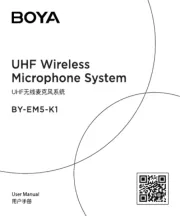
27 April 2025
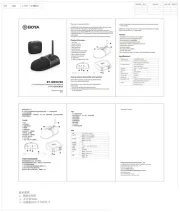
18 April 2025
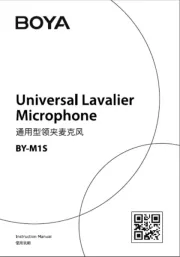
18 April 2025
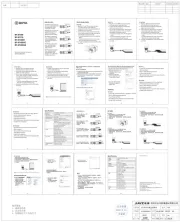
18 April 2025

27 Januari 2025

27 Januari 2025

18 December 2024
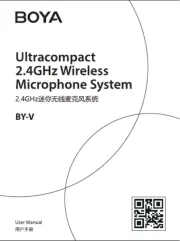
3 December 2024
Handleiding Microfoon
- IMG Stageline
- DJI
- Steelseries
- Kogan
- CAD Audio
- SmallRig
- Catchbox
- Tonor
- Audio-Technica
- Kopul
- Lectrosonics
- Solid State Logic
- NZXT
- Brigmton
- Peerless-AV
Nieuwste handleidingen voor Microfoon

15 September 2025
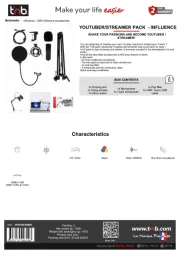
15 September 2025
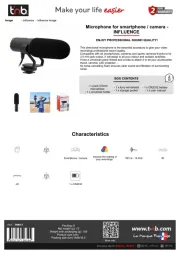
15 September 2025

15 September 2025

15 September 2025

15 September 2025

15 September 2025

15 September 2025

15 September 2025
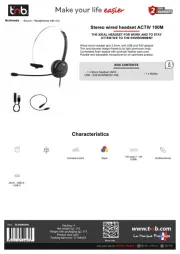
15 September 2025